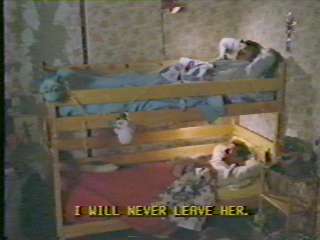
All questions pertain to My Other Husband and Film Art. Each is worth ten points (except where noted). Most answers should be approximately 150 words. Word-processed answers are preferred, but legibly handwritten ones are also acceptable.
Questions #1 and 2 refer to the Christmas party scene, illustrations for which are available over here.
1. Describe the mise-en-scene of the sequence shown in class. How does it function in terms of the narrative? Be sure to discuss setting, costume, lighting, figure expression, and figure (not camera) movement. (worth 15 points)
2. Diagram all of this sequence's camera and actor positions from an overhead view--as Bordwell and Thompson do on page 286, but do not draw the frames. Does its editing adhere to the 180 degree system? Explain. (15 points)
3. How do the cinematographic qualities (using this term specifically as Bordwell and Thompson do) of the single shot indicated in class (see below) function in terms of the narrative? Be sure to discuss the photographic aspects and framing of the shot.

4. Cite examples from My Other Husband of diegetic and nondiegetic music. Explain why each is diegetic or nondiegetic. Cite examples of simultaneous and nonsimultaneous diegetic sound. If there are no instances of simultaneous/nonsimultaneous diegetic sound in My Other Husband you may use other films.
5. What do Bordwell and Thompson call "the process whereby a film cues the spectator to compare two or more distinct elements by highlighting some similarity"? Explain how this process is developed in My Other Husband.
6. Discuss a motif in the film. How does it change and develop over the course of the film?
7. How do the "story" and the "plot" of My Other Husband differ in order, duration and/or frequency?
8. Fill in the blanks: (a) The aspect ratio of the videotape of My Other Husband we viewed was __________. (b) One Russian filmmaker sought to maximize the "collision" between one shot and the next, creating __________ editing. (c) The opposite of a match cut is a(n) _________ cut, in which conventions of spatial, temporal and graphic continuity are violated. (d) The sound from one scene may linger briefly while the image is already presenting the next scene; this is called a __________. (e) Shot A presents someone looking at something offscreen; shot B shows us what is being looked at, but not through the character's eyes (as in a subjective shot). This cut is an example of a(n) __________ match. (worth five points total)
Last revised:
August 25, 1999
Comments: jbutler@ua.edu